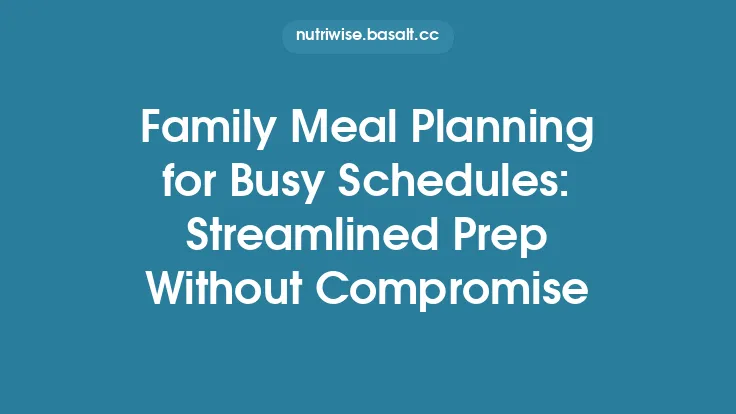Preparing meals ahead of time can feel like a daunting chore, especially when life’s demands pull you in every direction. Yet, with a mindful approach, meal prep transforms from a source of stress into a calming, empowering routine. By treating each step as an intentional act—rather than a rushed checklist—you create space for clarity, efficiency, and nourishment. Below is a comprehensive, step‑by‑step guide that walks you through the entire process, from the moment you consider your week’s schedule to the final plate you serve. The focus is on evergreen practices that remain useful regardless of trends, dietary preferences, or kitchen equipment.
Understanding Mindful Meal Prep
Mindful meal prep is more than just cooking in bulk; it is a structured practice that blends practical organization with present‑moment awareness. The core principles include:
- Purposeful Planning – Aligning meals with nutritional goals, time constraints, and personal preferences.
- Conscious Selection – Choosing ingredients that support health, sustainability, and flavor.
- Deliberate Execution – Performing each task with attention, minimizing multitasking that can lead to errors or accidents.
- Thoughtful Storage – Using methods that preserve texture, flavor, and safety while simplifying future meals.
When these elements are integrated, the kitchen becomes a space of calm efficiency rather than chaos.
Step 1: Setting Intentions and Assessing Your Schedule
- Map Your Week – Write down work hours, meetings, workouts, and any social commitments. Identify windows where you can realistically allocate 60–90 minutes for prep.
- Define Your Goals – Are you aiming for weight management, higher protein intake, or simply reducing daily cooking time? Clear goals guide portion sizes and ingredient choices.
- Establish a Mindful Cue – Before you begin, pause for a brief mental check‑in. A simple affirmation such as “I am creating nourishment for my body and mind” sets a purposeful tone without requiring elaborate breathing exercises.
Step 2: Inventory and Ingredient Selection
- Pantry Audit – List staples (grains, legumes, canned goods, spices) and note expiration dates. This prevents unnecessary purchases and reduces waste.
- Fresh Produce Review – Assess what’s already in the fridge and freezer. Prioritize using perishable items first.
- Create a Master List – Combine the audit with your weekly menu ideas. Categorize items by type (protein, carbohydrate, vegetable, fat) to ensure balanced nutrition.
- Select Versatile Ingredients – Choose components that can be repurposed across multiple meals (e.g., roasted chicken can become salad protein, soup filler, or sandwich filling).
Step 3: Designing a Balanced Menu
- Macro Distribution – Aim for a ratio that fits your goals, such as 40 % carbs, 30 % protein, 30 % healthy fats. Use a simple spreadsheet to calculate grams per serving.
- Color and Texture Variety – Incorporate at least three different colors and two textures per meal to keep dishes appealing.
- Batch‑Friendly Recipes – Opt for dishes that scale well, such as grain bowls, sheet‑pan roasts, stews, and salads that hold up after refrigeration.
- Seasonal Alignment – Choose produce that’s in season for optimal flavor and cost efficiency.
Step 4: Efficient Shopping Strategies
- Organized List – Group items by store sections (produce, bulk, dairy, frozen) to minimize back‑and‑forth movement.
- Bulk Purchasing – For non‑perishables (e.g., quinoa, lentils, nuts), buying in bulk reduces packaging waste and cost.
- Quality Checks – Inspect fresh produce for firmness, color, and any signs of spoilage. For meat and fish, verify that packaging is intact and dates are acceptable.
- Eco‑Conscious Choices – Bring reusable bags, containers, and produce bags to reduce single‑use plastics.
Step 5: Preparing Your Workspace
- Clear the Counter – Remove unrelated items to create a clean, distraction‑free zone.
- Set Up Stations – Designate separate areas for washing, chopping, cooking, and assembling. This “flow” mirrors an assembly line, reducing unnecessary movement.
- Gather Tools – Ensure knives are sharpened, cutting boards are stable, and measuring devices are at hand. Having everything ready prevents interruptions.
- Sanitize Surfaces – Wipe down countertops and handles with a food‑safe sanitizer before handling ingredients.
Step 6: Batch Cooking Techniques
a. One‑Pot/One‑Pan Methods
- Sheet‑Pan Roasting – Arrange protein and vegetables on a single tray, season uniformly, and roast at 200 °C (400 °F) for 20–30 minutes. This method requires minimal monitoring and yields caramelized flavors.
- Stovetop Simmer – Use a large pot for grains, legumes, or soups. Bring to a boil, then reduce to a gentle simmer, covering to retain moisture.
b. Parallel Cooking
- While the oven handles a roast, use the stovetop for a grain (e.g., quinoa) and a second burner for a quick sauté (e.g., greens). Timing is crucial: start with the longest‑cooking item and add shorter tasks as the oven preheats.
c. Sous‑Vide (Optional)
- For precise protein texture, vacuum‑seal portions and cook in a water bath at a controlled temperature (e.g., 60 °C/140 °F for chicken breast). This technique preserves moisture and reduces the need for constant attention.
d. Pre‑Seasoning and Marinating
- Combine spices, acids (lemon juice, vinegar), and oils in a bowl, then coat proteins or vegetables. Allow at least 15 minutes for flavor absorption; longer marination can occur during refrigeration.
Step 7: Portioning and Storage Best Practices
- Portion Control – Use a kitchen scale to allocate exact gram amounts for each macro component. This ensures consistency across meals.
- Container Selection – Opt for BPA‑free, airtight containers. Glass is ideal for reheating, while compartmentalized containers keep components separate.
- Labeling System – Write the date and contents on each container with a waterproof marker. Include a quick reference to the macro breakdown if desired.
- Cooling Before Refrigeration – Allow hot foods to reach room temperature (no more than two hours) before sealing. This prevents condensation and bacterial growth.
- Freezing Guidelines – For meals intended to be stored longer than three days, freeze in portion‑sized bags, removing as much air as possible. Use a “first‑in, first‑out” rotation to maintain freshness.
Step 8: Reheating and Serving with Presence
- Gentle Reheat – Use a stovetop skillet on low to medium heat for stir‑type dishes, adding a splash of water or broth to prevent drying. For soups and stews, a microwave on 50 % power with intermittent stirring preserves texture.
- Check Temperature – Aim for an internal temperature of at least 74 °C (165 °F) for proteins to ensure safety.
- Final Touches – Add fresh herbs, a squeeze of citrus, or a drizzle of quality oil just before serving. This re‑introduces brightness and signals the transition from storage to consumption.
- Mindful Eating Cue – Before the first bite, pause briefly to notice the aroma, color, and temperature. This simple pause bridges the preparation process with the act of nourishment.
Step 9: Maintaining Momentum and Reflecting on the Process
- Weekly Review – At the end of each week, note which meals were most satisfying, which storage methods performed best, and any adjustments needed for portion sizes.
- Iterative Improvements – Tweak recipes based on feedback (e.g., increase seasoning, adjust cooking times). Small refinements keep the routine fresh and aligned with evolving tastes.
- Time Audit – Track the total minutes spent on prep, cooking, and cleanup. Over time, you’ll identify efficiencies—perhaps a new tool or a streamlined workflow.
- Celebrate Consistency – Recognize the habit you’ve built. Consistency in mindful meal prep contributes to long‑term health benefits and reduces daily decision fatigue.
Integrating Mindful Meal Prep into Daily Life
By following this structured, step‑by‑step framework, you cultivate a kitchen routine that supports both physical health and mental clarity. The process emphasizes intentional planning, efficient execution, and thoughtful storage—all anchored in present‑moment awareness without the need for elaborate rituals. Over time, the habit of mindful meal prep becomes second nature, freeing mental bandwidth for other priorities while ensuring you consistently enjoy balanced, home‑cooked meals.
Embrace the rhythm of preparation, and let each batch of food be a reminder that nourishment can be both practical and peaceful.





